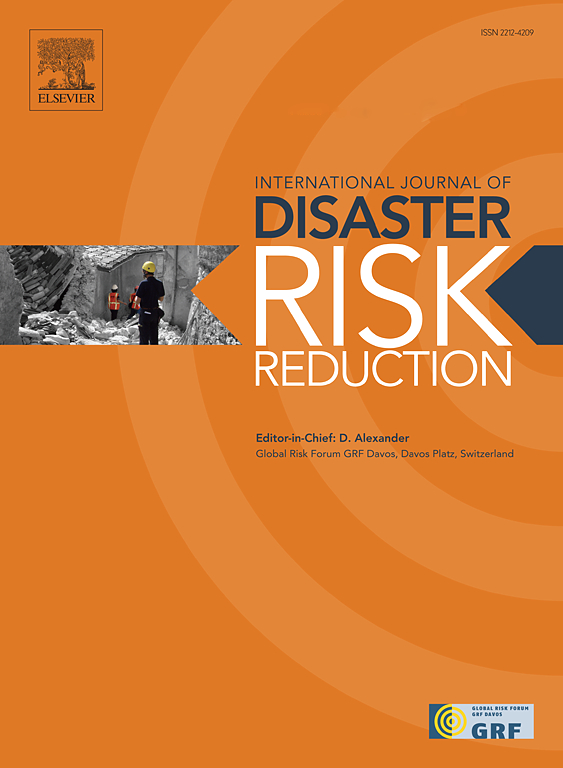适用于瑞典的多重危害评估方法
IF 4.2
1区 地球科学
Q1 GEOSCIENCES, MULTIDISCIPLINARY
International journal of disaster risk reduction
Pub Date : 2024-11-01
DOI:10.1016/j.ijdrr.2024.104934
引用次数: 0
摘要
尽管通过各种国际倡议为减少全球变暖做出了广泛努力,但已经确定人类引起的气候变化已经到来,目前对气候的破坏程度是前所未有的,并将持续下去。天气的不稳定性预计会越来越大,这很可能会增加与天气相关的危险,如野火、洪水。本文旨在介绍一种基于指数的多灾害风险评估方法,用于评估瑞典两个城市的野火和洪水灾害。该方法旨在供消防和救援服务部门(FRS)用于规划目的,并可根据当地消防和救援服务部门的能力和当地条件进行修改,从而提高地方一级的灾害防备能力。所做的分析表明,虽然瑞典北部地区野火和洪水造成的多种危害重叠的频率最高,但即使在重叠程度有限的地区,该方法也能提供重要信息。研究了使用盒核滑动窗口进行危害评估的变体,以调查模型对单个危害等级快速变化的敏感性。鉴于大规模自然灾害的资源需求通常会持续数天,箱核方法在帮助确定可能需要与事件响应相关的资源的天数跨度方面非常有价值。未来,该模型应扩展到更多的单一灾害,应用于更多的城市,并扩展到自然灾害的 FRS 规划工作中。本文章由计算机程序翻译,如有差异,请以英文原文为准。
A methodology for assessing multiple hazards applied to Sweden
Despite extensive efforts through various international initiatives to reduce global warming, it has been determined that human induced climate change is here, that the present scale of disruption of the climate is unprecedented and will continue. Increasing weather volatility can be expected, which will most likely increase exposure to weather related hazards, e.g. wildfires, flooding. The aim of this paper is to present an index-based multi-hazard risk assessment method to assess wildfires and flooding hazard for two municipalities within Sweden. The method is designed to be used by the Fire and Rescue Service (FRS) for planning purposes and can be modified to take the local FRS's capabilities and local conditions into account, thereby improving hazard preparedness at a local level. The analysis presented indicates that, while the frequency of multi-hazard overlap from wildfires and flooding is greatest in more northern parts of Sweden, the method provides important information even when applied to areas with limited overlap. A variation of the hazard assessment using a box kernel sliding window was studied to investigate the sensitivity of the model for rapid variations of an individual hazard level. Given that resource needs will typically spread over several days for large scale natural hazards, the box kernel approach is valuable in helping to identify a span of days when resources associated with incident response might be needed. In the future, the model should be expanded to include additional single hazards, the application to additional municipalities and extension to FRS planning exercises for natural hazards.
求助全文
通过发布文献求助,成功后即可免费获取论文全文。
去求助
来源期刊

International journal of disaster risk reduction
GEOSCIENCES, MULTIDISCIPLINARYMETEOROLOGY-METEOROLOGY & ATMOSPHERIC SCIENCES
CiteScore
8.70
自引率
18.00%
发文量
688
审稿时长
79 days
期刊介绍:
The International Journal of Disaster Risk Reduction (IJDRR) is the journal for researchers, policymakers and practitioners across diverse disciplines: earth sciences and their implications; environmental sciences; engineering; urban studies; geography; and the social sciences. IJDRR publishes fundamental and applied research, critical reviews, policy papers and case studies with a particular focus on multi-disciplinary research that aims to reduce the impact of natural, technological, social and intentional disasters. IJDRR stimulates exchange of ideas and knowledge transfer on disaster research, mitigation, adaptation, prevention and risk reduction at all geographical scales: local, national and international.
Key topics:-
-multifaceted disaster and cascading disasters
-the development of disaster risk reduction strategies and techniques
-discussion and development of effective warning and educational systems for risk management at all levels
-disasters associated with climate change
-vulnerability analysis and vulnerability trends
-emerging risks
-resilience against disasters.
The journal particularly encourages papers that approach risk from a multi-disciplinary perspective.
 求助内容:
求助内容: 应助结果提醒方式:
应助结果提醒方式:


